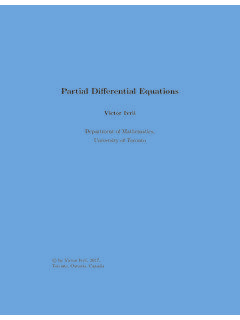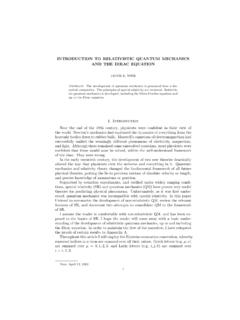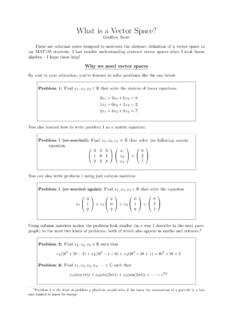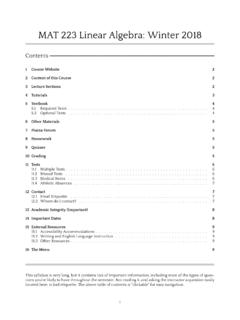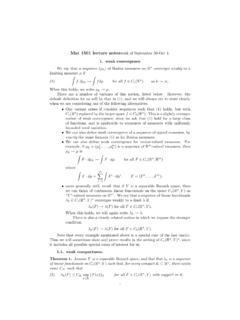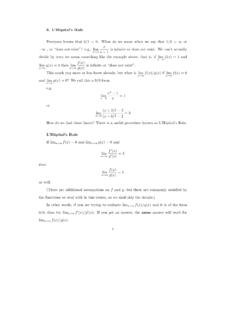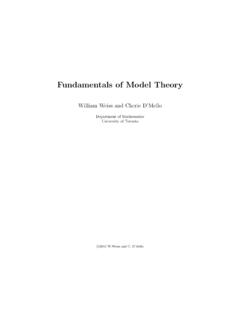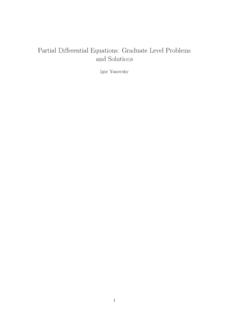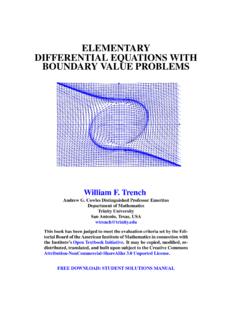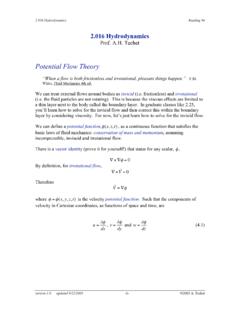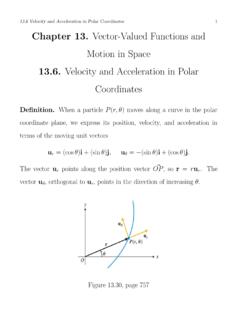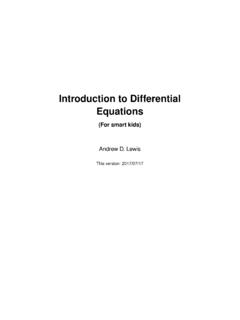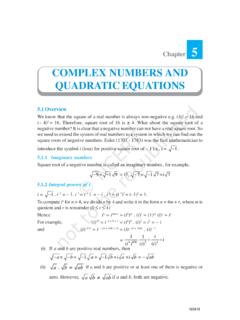Transcription of Partial Differential Equations - University of Toronto ...
1 Partial Differential EquationsVictor IvriiDepartment of Mathematics, University of Torontoc by Victor Ivrii, 2017, Toronto , Ontario, CanadaContentsContentsiPreface ..iv1 PDE Motivations and Context .. Initial and Boundary Value Problems .. Classification of Equations .. Origin of some Equations ..10 Problems to Chapter 1 ..1421-dimensional First order PDEs .. Appendix .. First order PDEs (continued) .. Homogeneous 1D Wave equation .. 1D Wave equation reloaded: characteristic coordinates .. Wave equation reloaded (continued) .. 1D Wave equation: IBVP .. Energy integral .. Hyperbolic first order systems with one spatial variable ..613 Heat equation in 1D Heat equation.
2 Heat equation (Miscellaneous) .. Project: Walk Problem ..854 Separation of variables and Fourier Separation of variables (the first blood) .. Eigenvalue problem .. Orthogonal systems .. Ortogonal systems and Fourier series .. Other Fourier series .. Calculation of negative eigenvalues in Robin problem .. Multidimensional Fourier series .. Harmonic Oscillator .. 1215 Fourier Fourier transform, Fourier integral .. Appendices .. Properties of Fourier transform .. Appendix .. Applications of Fourier transform to PDEs .. 1396 Separation of Separation of variables for heat equation .. Separation of variables: Misc Equations .. Laplace operator in different coordinates.
3 Laplace operator in the disk: separation of variables .. Laplace operator in the disk. II .. Linear second order ODEs .. Problems to Chapter 6 .. 1747 Laplace General properties of Laplace equation .. Potential theory and around .. Green function .. 1858 Separation of Separation of variable in spherical coordinates .. Separation of variable in polar and cylindrical coordinates . Separation of variable in elliptic and parabolic coordinates . 1999 Wave Wave equation in dimensions 3 and 2 .. Wave equation: energy method .. 20910 Variational Functionals, extremums and variations .. Functionals, extremums and variations .. Variational methods in physics.
4 22511 Distributions and weak Distributions .. Distributions: more .. Applications of distributions .. Weak solutions .. 24612 Nonlinear Burgers equation .. 24913 Eigenvalues and Variational theory .. Asymptotic distribution of eigenvalues .. Properties of eigenfunctions .. About spectrum .. Continuous spectrum and scattering .. 28514 Conservation laws .. Maxwell Equations .. Some quantum mechanical operators .. 295A Field theory .. Some notations .. 301 ContentsivPrefaceThe current version is in the online online Textbook based on half-year course APM346 at Departmentof Mathematics, University of Toronto (for students who are not mathematicsspecialists, which is equivalent to mathematics majors in USA) but containsmany Textbook isfreeandopen(which means that anyone can use itwithout any permission or fees) andopen-source(which means that anyonecan easily modify it for his or her own needs) and it will remain this wayforever.
5 Source (in the form of Markdown) of each page could be downloaded:this page s URL its source s URL for all other pages Source of the whole book could be downloaded as well. Also couldbe downloaded Textbook in pdf format and TeX Source (when those areready).While each page and its source are updated as needed those three areupdated only after semester , it will remain free and freely available. Since it free it doesnot cost anything adding more material, graphics and so textbook ismaintained. It means that it could be modified almostinstantly if some of students find some parts either not clear emough orcontain misprints or errors. PDF version is not maintained during semester(but after it it will incorporate all changes of the online version).
6 This textbook istruly digital. It contains what a printed textbook cannotcontain in principle: clickable hyperlinks (both internal and external) anda bit of animation (external). On the other hand, CouseSmart and its ilkprovide only a poor man s digital copy of the printed should remember that you need an internet connection. Even if yousave web pages to parse mathematical expression you need MathJax whichis loaded from the cloud. However you can print every page to pdf to keepon you computer (or download pdf copy of the whole textbook).Due to html format the online versionreflowsand can accommodateitself to the smaller screens of the tablets without using too small fonts. Idoubt if one can read it comfortably on smart phones (too small screens).
7 ContentsvOn the other hand, pdf does not reflow but has afidelity: looks exactly thesame on any screen. Each version has its own advantages and , it is less polished than available printed textbooks but it is IvriiDepartment of MathematicsUniversity of TorontoThis work is licensed under a Creative Commons Attribution-ShareAlike Inter-national one needs to know?SubjectsRequired:1. Multivariable Calculus2. Ordinary Differential EquationsAssets:(useful but not required)3. Complex Variables,4. Elements of (Real) Analysis,5. Any courses in Physics, Chemistry etc using PDEs (taken previouslyor now).1. Multivariable CalculusDifferential calculus(a) Partial Derivatives (first, higher order), Differential , gradient, chainrule;(b) Taylor formula;(c)Extremums, stationary points, classification of stationart points usingsecond derivatives;Asset:Extremums with calculus(d) Multidimensional integral, calculations in Cartesian coordinates;(e)Change of variables, Jacobian, calculation in polar , cylindrical, spheri-cal coordinates;(f) Path, Line, Surface integrals, calculations;(g) Green, Gauss, Stokes formulae;(h) u, A, A, uwhereuis a scalar field andAis a vector Ordinary Differential EquationsFirst order Equations (a) Definition, Cauchy problem, existence and uniqueness.
8 (b) Equations with separating variables, integrable, order Equations (c) Definition, Cauchy problem, existence and uniqueness;Linear Equations of order 2(d) General theory, Cauchy problem, existence and uniqueness;(e)Linear homogeneous Equations , fundamental system of solutions, Wron-skian;(f) Method of variations of constant Equations of order 2with constant coefficients(g) Fundamental system of solutions: simple, multiple, complex roots;(h)Solutions for Equations with quasipolynomial right-hand expressions;method of undetermined (i) General systems, Cauchy problem, existence and uniqueness;(j)Linear systems, linear homogeneous systems, fundamental system ofsolutions, Wronskian;(k) Method of variations of constant parameters;(l) Linear systems with constant PDE Motivations and ContextThe aim of this is to introduce and motivate Partial Differential Equations (PDE).
9 The section also places the scope of studies in APM346 within thevast universe of What is a PDE?Apartial Differential equation (PDE)is anequationinvolvingpartial deriva-tives. This is not so informative so let s break it down a is a Differential equation?Anordinary Differential equation (ODE)is an equation for a function whichdepends on one independent variable which involves the independent variable,the function, and derivatives of the function:F(t,u(t),u(t),u(2)(t),u(3)(t),. .,u(m)(t)) = is an example of an ODE ofdegreemwheremis a highest order ofthe derivative in the equation. Solving an equation like this on an intervalt [0,T] would mean finding a functoint7 u(t) Rwith the propertythatuand its derivatives intertwine in such a way that this equation is truefor all values oft [0,T].
10 The problem can be enlarged by replacing thereal-valueduby a vector-valued oneu(t) = (u1(t),u2(t),..,uN(t)). In thiscase we usually talk aboutsystem of 1. Introduction2 Even in this situation, the challenge is to find functions dependingupon exactly one variable which, together with their derivatives, satisfy is a Partial derivative?When you have function that depends upon several variables, you candifferentiate with respect to either variable while holding the other variableconstant. This spawns the idea ofpartial derivatives. As an example,consider a function depending upon two real variables taking values in thereals:u:Rn 2 we sometimes visualize a function like this by considering itsgraphviewed as a surface inR3given by the collection of points{(x,y,z) R3:z=u(x,y)}.
